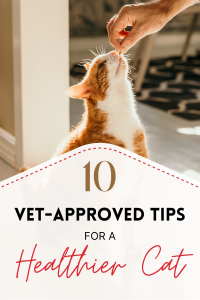10 Vet-Approved Tips for a Healthier Cat!

Unlocking a Lifetime of Purrs: 10 Vet-Approved Tips for a Healthier Cat
Cats are enigmatic creatures, celebrated for their independence, grace, and sometimes, their mysterious ways. As devoted cat parents, we want nothing more than for our feline companions to live long, healthy, and happy lives. While their self-sufficient nature might lead some to believe they require minimal care, the truth is that proactive measures and attentive observation are key to ensuring their well-being. To help you navigate the world of feline health, we’ve compiled ten vet-approved tips that can make a significant difference in your cat’s vitality and longevity.
1. The Foundation of Health: A High-Quality, Balanced Diet
Just like humans, a cat’s health begins with what they eat. Cats are obligate carnivores, meaning their bodies are designed to thrive on a diet rich in animal protein. Look for cat foods where meat, poultry, or fish are listed as the primary ingredients. Avoid foods with excessive fillers, by-products, or artificial additives.
Veterinarians often recommend incorporating wet food into your cat’s diet, as it provides crucial hydration that dry kibble alone often lacks. Many cats, especially those on an exclusively dry food diet, can be chronically dehydrated, which can contribute to urinary tract issues and kidney problems. Discuss your cat’s age, activity level, and any specific health concerns with your veterinarian to determine the best nutritional plan and appropriate portion sizes. Free-feeding (leaving food out all day) can lead to obesity, a common and serious health issue in cats.
2. Hydration is Key: Encouraging Ample Water Intake
Building on the previous point, proper hydration is paramount. Cats, as descendants of desert dwellers, don’t have a strong thirst drive. This makes it challenging to ensure they drink enough water. Beyond wet food, consider investing in a pet water fountain, as many cats are attracted to the flowing water. Offer multiple water bowls in different locations, ensuring they are clean and refilled daily. Some cats even prefer ceramic or glass bowls over plastic.
3. The Power of Prevention: Regular Veterinary Check-ups
Even if your cat appears perfectly healthy, annual (or biannual for senior cats) veterinary check-ups are non-negotiable. These routine visits allow your vet to perform a thorough physical examination, detect subtle changes that might indicate early-stage health issues, and keep vaccinations up-to-date. Early detection of conditions like dental disease, kidney disease, hyperthyroidism, or diabetes can lead to more effective treatment and a better prognosis. Your vet can also provide personalized advice on parasite prevention (fleas, ticks, worms) based on your cat’s lifestyle.
4. Dental Health Matters: Beyond Fresh Breath
Dental disease is one of the most common health problems in cats, affecting a vast majority of felines over the age of three. Plaque and tartar buildup can lead to gingivitis, painful extractions, and even systemic health issues if bacteria from the mouth enter the bloodstream.
While regular professional dental cleanings under anesthesia are often necessary, you can support your cat’s oral health at home. Introduce tooth brushing with a cat-specific toothbrush and toothpaste (never human toothpaste!) gradually and patiently. Dental treats and certain dental diets can also help, but always consult your vet for the most effective strategies for your cat.
5. Get Them Moving: Regular Exercise and Play
Obesity is a growing epidemic among domestic cats, leading to a myriad of health problems including diabetes, arthritis, and heart disease. Regular exercise is crucial for maintaining a healthy weight and providing mental stimulation.
Engage your cat in interactive play sessions daily using wand toys, laser pointers (but always end with a tangible reward like a treat to prevent frustration), or puzzle feeders that encourage them to “hunt” for their food. Cat trees, climbing shelves, and scratching posts satisfy their natural instincts to climb, scratch, and observe their surroundings from elevated perches, contributing to both physical and mental well-being.
6. The Litter Box Lowdown: Cleanliness and Accessibility
A clean and appropriately placed litter box is vital for both your cat’s physical and psychological health. Cats are fastidious creatures and can develop litter box aversion if their environment isn’t up to their standards.
Scoop the litter box at least once daily, and thoroughly clean and replenish the litter entirely every 1-2 weeks, depending on the type of litter. The general rule of thumb for multi-cat households is one litter box per cat, plus one extra. Ensure the litter box is in a quiet, accessible location, away from their food and water bowls. Changes in litter box habits (e.g., urinating outside the box, straining, frequent visits) warrant immediate veterinary attention, as they can be signs of serious medical conditions.
7. Grooming for Good Health: More Than Just a Pretty Coat
While cats are renowned self-groomers, they still benefit from human assistance, especially long-haired breeds or those with mobility issues. Regular brushing helps to remove loose fur, preventing uncomfortable mats and reducing hairballs. It also stimulates blood circulation to the skin and distributes natural oils, leading to a healthier, shinier coat.
Use grooming sessions as an opportunity to check for any lumps, bumps, parasites, or skin irritations. Regular nail trims are also important to prevent ingrown nails and discomfort. If your cat resists grooming, introduce it gradually with positive reinforcement.
8. Mental Stimulation and Environmental Enrichment:
Boredom can lead to stress and behavioral problems in indoor cats. Provide a stimulating environment with a variety of toys, scratching surfaces (both horizontal and vertical), and opportunities for vertical exploration (cat trees, shelves). Rotate toys regularly to keep things interesting. Consider window perches where your cat can watch birds and the outside world. Puzzle toys that dispense treats can also provide engaging mental challenges.
9. Spay or Neuter: A Crucial Step for Health and Behavior
Spaying or neutering your cat offers numerous health and behavioral benefits. For females, it eliminates the risk of uterine infections and tumors, and significantly reduces the risk of mammary cancer. For males, it reduces the risk of testicular cancer and certain prostate problems. Beyond health, it often curtails undesirable behaviors such as spraying, roaming, aggression, and the incessant vocalization associated with heat cycles. It also plays a vital role in controlling pet overpopulation.
10. Be an Observer: Recognizing Subtle Changes
Cats are masters at hiding illness, a survival instinct from their wild ancestors. As a result, subtle changes in their behavior or routine can be the earliest indicators of a health problem. Pay close attention to changes in appetite, thirst, litter box habits (frequency, volume, consistency), activity levels, sleep patterns, grooming habits, and vocalizations. Any sudden or persistent changes warrant a call to your veterinarian. Early intervention can make a world of difference in the outcome of many conditions.
By implementing these ten vet-approved tips, you’re not just providing basic care; you’re actively investing in your cat’s long-term health and happiness. A healthy cat is a happy cat, and the bond you share will only grow stronger with every purr.

Leave a Reply